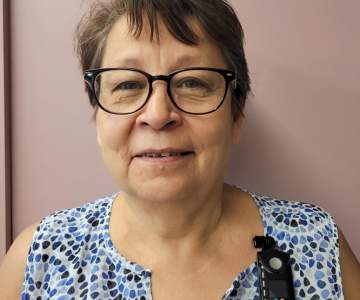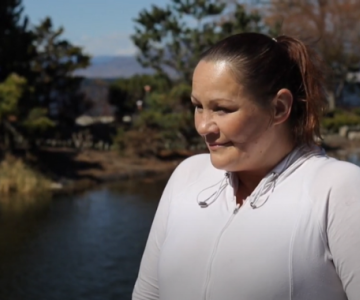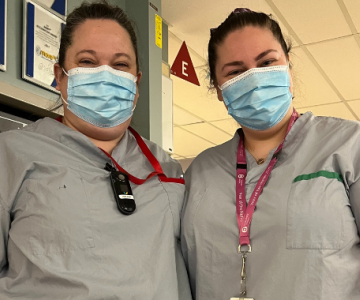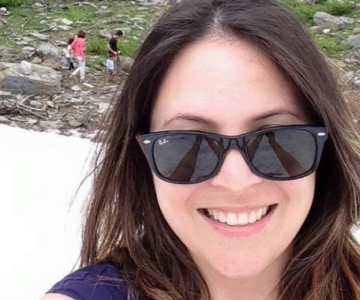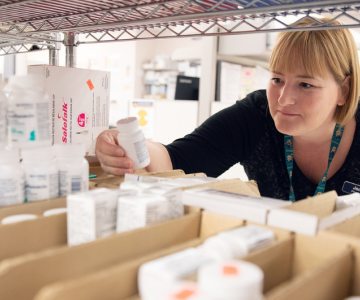Breadcrumb
Explore Stories
Health & Wellness
On April 14, 2016, the increasing number of opioid overdoses prompted the Province to declare a public health emergency. Six years later, close to 1,500 family members, friends, coworkers, teammates, neighbours and friends have been lost to overdose within the Interior Health (IH) region alone.
Inspired by the International Black Balloon Day, on April 14 IH’s mental health and substance use teams and community partners will display black balloons in recognition of this sombre anniversary.
Community & Culture
Name: Patti Ironstand (she/her/hers)Job Title: Registered Psychiatric NurseYears of Service: 11Worksite: Gillis HouseCommunity: MerrittAncestral Territory: Nlaka’pamux and Syilx NationsAdvice to live by: Give to people what you would like to receive.
Patti Ironstand is an Aboriginal woman, originally from North Battleford, Sask., who has worked in health care since 1985, including 11 years with Interior Health. Patti has always worked with seniors, going so far as to call it her passion.
“I love working with seniors – they are the Knowledge Keepers.”
Health & Wellness
Like many people who use drugs, Faith turned to illicit opioids to take away pain and hurt. When she realized she wanted to stop using, Opioid Agonist Treatment, or OAT, was key.
Research & Innovation
Our family was recently impacted by an emergency, and an aging relative was hospitalized. With ongoing restrictions due to COVID, there were limitations to in-person visits and some family members involved in care live afar. After the acute event was over and our aging loved one was back home, I reflected on how much of our communication and caregiving was done virtually – texting, email, videoconference, apps to feel closer to each other, online booking for transportation and apps designed to help coordinate tasks and scheduling.
Using technology-based interventions and other digital applications is increasingly becoming a viable option to support family caregivers both in their role as a caregiver and for their own well-being.
Community & Culture
Jennifer Thur (left), an Obstetrics Registered Nurse at Royal Inland Hospital, and Jessica Rathgeber, Obstetrics Nursing Student
We’re privileged at Interior Health to support more than 6,000 students who walk through our doors, breathing fresh excitement into our hallways. Preceptorship, the advising relationship between an experienced professional and a student entering the field, serves as an absolute cornerstone of education in health care.
IH’s dedicated employees spend more than 500,000 hours serving as preceptors across the organization each year.
Research & Innovation
If necessity is the mother of invention, then it only makes sense that the need for continued interaction with each other during the pandemic lockdown meant people changed the way they communicated. By adopting more innovative avenues like videoconferencing, they found they could successfully achieve many tasks – including the ability to have a quality virtual health-care appointment with their care provider.
Even for people who don’t consider themselves to be savvy with computers, improved technology and support makes virtual visits easier. In fact, many people find virtual visits are more convenient to fit into their busy schedules than an in-person visit.
Community & Culture
Name: Ryan Benson (she/her/hers)Job Title: Improvement ConsultantYears of Service: 14Worksite: Community Health & Services CentreCommunity: KelownaAncestral Territory: SyilxAdvice to live by: “Life is short – use the good china.” - Unknown
As an Improvement Consultant with Interior Health, Ryan Benson likes to bring positivity and a sense of a can-do attitude to everything she encounters in her day.
Health & Wellness
Medications are prescribed to treat symptoms and to manage medical conditions or mitigate the risk of future events. It’s important to take the right medication at the right time and in the right dose. When we don’t take medications properly, it can lead to ineffectiveness, side effects and possibly even harm.
There are many reasons why someone may not take their medications properly. Patients may stop taking their medications because they’re confused by the directions, they feel the medications aren’t working, or because of the side effects. Cost can be another barrier to taking medications properly. Some patients may skip doses or reduce frequency to extend the medication so that it lasts longer.
Pharmacists are a great option for helping people manage their medication.
Health & Wellness
Housing is both a basic need and a human right. And yet, many people in the Interior Health region are without homes.
The reasons behind why someone may become homeless are complex, interconnected and are no fault of the individual. In fact, homelessness can happen to anyone – and the stigma associated with not having a home can create barriers to healthy living opportunities for those who are experiencing homelessness.
“Having a home is a basis for everything. Without it, it’s impossible to do anything … all you can do is survive,” says Shane, a resident at a Vernon supportive housing facility featured in a recent BC Housing video. “The general public considers us dirty and bad. And like, everybody’s a criminal, and that’s not the case.”
People without homes are constantly experiencing stigma, prejudice and discrimination. Terms such as “bum” and even labels such as “homeless person” dehumanize the person behind the situation and takes away from individual identity. Negative stereotypes and stigma increase the shame and embarrassment of people living without homes; this, in turn, creates barriers to seeking help and further perpetuates poor health outcomes. Using non-stigmatizing language can help.
Individuals living without housing are often in survival mode, trying to meet very real life-or-death needs like securing food to eat, finding a safe place to sleep and trying to stay out of the elements. People experiencing homelessness often have poorer physical and mental health outcomes, including high rates of infectious and chronic disease, severe mental illness, and premature death.
Having access to good quality, accessible, appropriate and affordable housing can support the health and well-being of individuals and communities. For example, access to affordable housing can reduce stress and allow people to take better care of themselves and their families by having more disposable income. More disposable income then allows people to spend money on healthy food, medication, recreational opportunities, and educational opportunities which, in turn, can help reduce health inequities.
As resident Jill says in the BC Housing video: “I don’t know that I’d ever be able to be who I am, and who I want to be … if I wouldn’t have had a place to live.”
Healthy housing contributes to a sense of safety, greater social well-being and improved quality of life.
Learn more:
Health & Housing Infographic _Page 1 (interiorhealth.ca)
Substance Use & Addiction Services | Health & Wellness | IH (interiorhealth.ca)
BC Housing video – My Place Supportive Housing in Vernon BC
BC Housing Podcast
-
Load More
Showing 477 of 786
Sign up for email updates
Receive news, alerts, public service announcements and articles right to your inbox.



